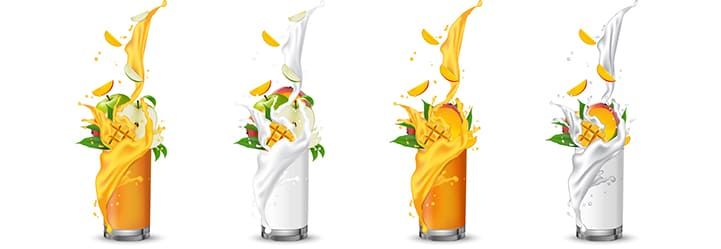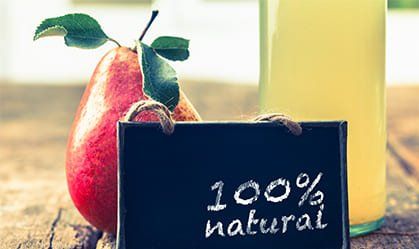Juice industry: top insights about its present and future
Alimentos SAS • Jan 05, 2022
Juice remains a favorite food product among consumers in the beverage category. In fact, it stands as a healthier alternative to soft drinks, which boosts its performance worldwide. Let’s explore all there is to know about the current state of the juice industry, as well as the trends and innovations driving its growth and future.
The essentials about juice
Nowadays, there are many types of juice available. There is something for everyone, from fruit juice to vegetable juice to blends of both. Similarly, juice content determines how the product is marketed. For example, pure juice means the product is a hundred percent juice. At the same time, a nectar drink contains between 25 and 50 percent juice, combined with sugar, water, and acid (Food and Agriculture Organization of the United Nations and World Health Organization, 2024).
Fruit juice is currently the most popular beverage in the juice industry. Essentially, it is a liquid extracted from fruits through crushing, pressing, or blending. Fruit juice's popularity stems from its delicious taste and nutritional benefits. Indeed, it is a solid source of vitamins, minerals, and natural sugars. As a result, consumers gravitate towards it as a convenient choice for nutritional intake (IMARC Group, 2025).
Market performance of the fruit juice industry
Last year, the global fruit juice market reached a value of USD 159.6 billion. Analysts expect it to hit USD 219.6 billion by 2033, with a Compound Annual Growth Rate (CAGR) of 3.6 percent between 2025 and 2033. The major factors propelling the industry are (IMARC Group, 2025):
- Increasing consumer health and wellness awareness, leading to a growing demand for natural food products. This also includes nutrient-dense products and functional drinks.
- Rising disposable incomes allow for the consumption of ready-to-drink products. Moreover, in this context, consumers become more willing to invest in premium food products. This is the case for high-quality fruit juices and functional beverages.
- Product innovations are positioning manufacturers to enhance their appeal to consumers. State-of-the-art processing techniques and exciting flavor combinations are key tools to expand producers’ available offer. Plainly said, a wider range of options tends to engage a wider customer base.
- Expanding retail channels are contributing to fruit juice market penetration.
Health-driven consumers turn to the juice industry
The beverage industry, like most other food industries, is always aiming to keep up with consumers’ interests. That is why manufacturers create and launch differential products to attract consumers. As a result, people seem to constantly be wondering about new products: what is fruited beer? What is cream soda? Are there differences between sparkling water vs. seltzer?
In this context of innovation, the juice industry is pointedly catering to health-driven consumers. This type of consumer is looking for products such as sugar free drinks and antioxidant drinks, just to name a few. Their main interest is choosing goods with the power to aid their health goals and concerns. Some of the leading trends include (IMARC Group, 2025; Knowledge Sourcing Intelligence, 2025):
- Favoring natural, minimally processed ingredients, such as fruit.
- Avoiding food products with artificial additives, preservatives, and sweeteners.
- Demanding clean-label products.
- Spending in nutrient-rich options, including fortified products and products made with
functional ingredients. The
juice industry is increasingly offering products that contain probiotics, vitamins, adaptogens, and plant-based extracts to address health and wellness needs.
How do these trends translate into product offers?
Some manufacturers concentrate on the most lucrative functional claims, such as metabolism support and additional health advantages, offering low-sugar or sugar-free beverages along with high-protein products. Others create solutions for immunity or gut health (NIQ, 2024; Innova Market Insights, 2024).
One leading example of catering to the health and wellness trend is organic juices. They are made using all-natural ingredients and completely excluding ingredients affected by synthetic pesticides, artificial additives, preservatives, and genetic engineering (Mordor Intelligence, 2025).
Moreover, there are other significant factors driving the positive performance of the juice industry.
Additional drivers of the juice industry
As mentioned, flavor variety and innovation are important to consumers. Today, novelty stems mainly from unique blends and exotic fruit combinations that create interesting flavor profiles (IMARC Group, 2025). This task often entails custom flavor development for a brand’s target market. Here, manufacturers draw from their understanding of consumer preferences, cultural trends, and emerging ingredients. As a result, personalized flavors cater to specific consumer interests (Bell, 2025).
On the other hand, advanced processing methods are aiding the production of more nutritional, high-quality juices. For instance, cold-press extraction preserves the flavor, freshness, and nutrients better than traditional methods. Similarly, sophisticated pasteurization techniques like high-pressure processing (HPP) are pushing the juice industry forward. HPP extends the product’s shelf life while maintaining natural flavor and nutritional integrity (Global Industry Analysts, 2025).
Furthermore, innovation is also key for the industry’s sustainability. Environmentally responsible sourcing and sustainable packaging are not only beneficial to producers but appealing to many consumers. Here, main trends include organic products, processes with reduced carbon footprints, and recyclable packaging (Global Industry Analysts, 2025). Sustainable materials are taking the lead with packaging options made from recycled paper, glass, and plastic, as well as completely recyclable materials such as aluminum and plant-based cartons. Other areas where sustainability is on the rise include reduced material usage, package design for maximum recyclability, and even reusable packaging (TIP Staff, n.d.).
Enjoy Alimentos SAS
As seen here, juice industry trends compel manufacturers to explore and exploit new ways to engage consumers successfully. As we mentioned, top-quality, natural ingredients are vital in creating products that resonate with today’s consumers. At Alimentos SAS, we provide fruit pulps using premium raw materials and cutting-edge infrastructure.
Our frozen fruit pulp and extended shelf-life fruit pulp are made from natural, clean, and healthy ripe fruit for maximum flavor, color, aroma, and texture. Our fruit supply is free of parasites, toxic residue from pesticides, and animal or vegetal remainders. Overall, our pulps offer high nutritional value, with no artificial colors or additives for flavoring. Additionally, they are a completely safe ingredient for the food industry, due to our pasteurization process.
In fact, we ensure the quality and safety of our fruit pulps with top-of-the-line technology and infrastructure, as well as high-quality suppliers. Our carefully designed industrial process turns fresh, ripe fruit into a valuable, safe, and convenient raw material available year-round. This is how our preservation process helps food manufacturers to bypass production issues derived from fresh fruit seasonality.
REFERENCES:
- Bell. (2025). The Future of Flavor Innovation: How Custom Flavor Development Drives Food and Beverage Trends. [Blog message].
- Food and Agriculture Organization of the United Nations and World Health Organization. (2024). Codex Alimentarus. General standard for fruit juices and nectars.
- Global Industry Analysts. (2025). Fruit Juices - Global Strategic Business Report. Research and Markets. https://www.researchandmarkets.com/reports/5302390/fruit-juices-global-strategic-business-report#tag-pos-3
- IMARC Group. (2025). Fruit Juice Market Report by Product Type, Flavor, Distribution Channel, and Region 2025-2033. Research and Markets.
- Innova Market Insights. (2024). Functional Beverage Trends: Global Market Overview. https://www.innovamarketinsights.com/trends/functional-beverage-trends/
- Knowledge Sourcing Intelligence LLP. (2025). Fruit Juice Market - Forecasts from 2025 to 2030. Research and Markets.
- Mordor Intelligence. (2025). Organic Drinks Market Size & Share Analysis - Growth Trends & Forecasts (2025 - 2030).
- NIQ. (2024). Hydrate and Heal: The Rise of Functional Beverages.
- TIP Staff. (n.d.). Beverage Packaging Innovation: 20 Examples from Around the World. Triangle IP.















